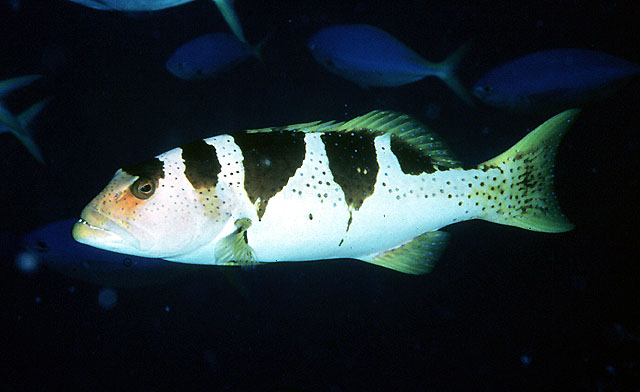| Epinephelidae (Groupers) |
| 125 cm TL (male/unsexed); max.weight: 24 kg |
|
reef-associated; marine; depth range 4 - 100 m |
| Indo-Pacific: Kenya to Delagoa Bay, Mozambique, eastward to the Tuamoto Islands, north to the Ryukyu Islands, south to Queensland, Australia and including most islands of the Indian Ocean and of western and central Pacific. Unknown in the Red Sea and Persian Gulf. Misidentified as Plectropomus maculatus by some authors (Ref. 6448, 6892). |
|
Dorsal spines (total): 7-8; Dorsal soft rays (total): 10-12; Anal spines: 3-3; Anal soft rays: 8-8. Description: Characterized by having two distinct color varieties, first is pale black-saddled form is whitish or pale yellowish with 5 dark brown to black, irregular, saddle like or wedge shaped bars or blotches on the dorsal part of head and body, 1st just behind the eyes, 2nd on the nape and 3rd to 5th under the dorsal fin; small dark-edged blue spots may be visible on the body; yellow colored fins, caudal peduncle, snout and jaws; black blotch centrally at the base of the paired fins; dark form is brown, olivaceous, red or nearly black, dark bars are usually faint or absent; numerous round, dark-edged blue spots on head and body, soft dorsal, caudal and anal fins and base of pectoral fins; pectoral fins dark brown distally, rays darker than membranes, rear edge white; flat interorbital area without scales; broadly rounded preopercle, with 3 large, ventrally directed spines along lower half; smooth interopercle and subopercle; opercle with 3 flat spines, upper and lower spines covered by skin; subequal in size, posterior and anterior nostrils, set in shallow groove running forward from eye; front of jaws with pair of large canine teeth (Ref. 89707); 1-4 large canines on side of lower jaw; elongate body, greatest depth 2.9-3.9 in SL; slightly emarginate caudal fin; pectoral and pelvic fins 2.1-2.5 in head length (Ref. 90102). |
| A voracious piscivore inhabiting coral-rich areas of lagoon and seaward reefs. Encountered most frequently in channels and outer shelf reefs. Migrate over short distances to spawn, forming large aggregations, maybe 1 or 2 per reef (Ref. 6390). Feeds mostly on fishes, and occasionally on crustaceans (Ref. 9710). The prey comprises a variety of large reef fishes, including groupers, and this diet of large fishes is responsible for the high concentrations of ciguatera toxins. Juveniles may mimic the pufferfish Canthigaster valentini. Usually wary (Ref. 9710). The young have a demersal existence in shallow water in reef habitats, especially around coral rubble (Ref. 27259). They feed on small fish and invertebrates such as crustaceans and squid (Ref. 27261). Eggs float just below the surface (Ref. 6390). The pelagic larvae are found in habitats similar to those of the adults (Ref. 27260). An excellent table fish (Ref. 6390). |
|
Least Concern (LC); Date assessed: 21 November 2016 Ref. (130435)
|
| reports of ciguatera poisoning |
|
Source and more info: www.fishbase.org. For personal, classroom, and other internal use only. Not for publication.

